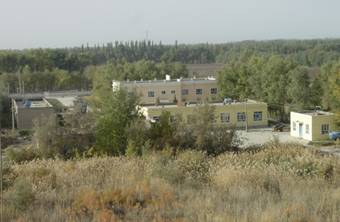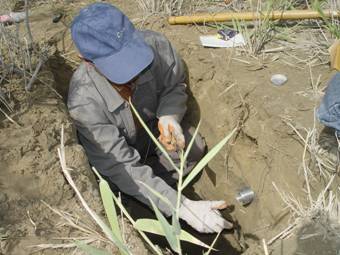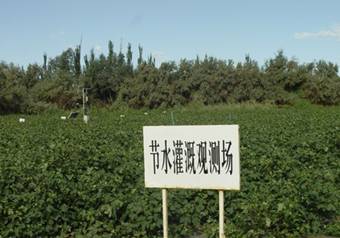Aksu National Field Scientific Observation and Research Station for Farmland Ecosystem
The Station was established as part of Chinese Ecosystem Research Network representing typical oasis agricultural ecosystem in 1982. It is located at the northern fringe of the Tarim Basin and near downstream Aksu River-a tributary of the Tarim River. The station is 1100 km from Urumqi, with a study area covering 80o51′-86o05′E, and 40o37′-41o30′N.

As a large and nationally important cotton producer, the area is characterized by dramatic watercourse changes and high agricultural water consumption. This forms an ideal location for research and monitoring of water, salt and nutrient processes in oasis cropland systems, which aid the study of sustainable development of oasis agriculture, and the development of the theory and technological demonstrations of water-saving irrigation.
The Station has an arid warm temperate climate, with an annual temperature of 11.2°C, and precipitation of 45.7 mm. Frost-free days, sunshine duration and annual mean wind velocity are 207 d, 2,940 h and 2.4 m/s, respectively. Disastrous weather includes dust storms in spring, hail and continuous high temperatures in summer.
The aim of the Station is to establish a world-class water balance experimental station for extreme arid regions, which will provide (1) a long-term platform for field observation of water, soil, atmosphere and biology in typical oasis cropland ecosystems; (2) demonstrations of management and sustainable agriculture in oasis cropland ecosystems; (3) training for scientists and promotion of popular science in oasis agriculture; and (4) a base for research cooperation and a platform for international communication.

Taking soil samples

Demonstration of water-saving irrigation
Research Fields
(1) Exchange processes among water, salt and heat in typical moderate cropland ecosystems and the eco-hydrological processes in GSPAC
(2) Dynamic movement of water, salts and nutrients, theory of water-saving irrigation in oasis cropland, and promotion of suitable technology
(3) Water consumption at individual plant, community and ecosystem levels in oasis-desert ecotones
Research Facilities
The Station has a laboratory building covering a total area of 608 m2, a guesthouse, a staff dormitory and an entertainment room, and is able to accommodate 50 researchers.
Since 1984, various observation sites have been established to monitor meteorology, surface water evaporation, groundwater evaporation, water balance, the dynamics of soil water and salts, nutrient cycling in soil, the vertical gradient of sand-storms, the groundwater table, and water consumption by individual plants. The stations specialized equipment includes auto-logged water surface vessels, lysimeters, ENVIS system, portable photosynthesis systems, PTM-48M system, SF Thermal Dissipation Probes, a 34 m high observation tower, a laser-radar system and water-saving irrigation systems.
Main Accomplishments
The Station has been awarded 35 research grants since 2000, including funding from the National 973 projects, 863 projects, NSFC projects, and international projects which cooperated with Germany, Canada, Japan and the USA. Scientists in the Station have published more than 130 papers, including 15 SCI journal papers, 5 EI papers and 15 international conference papers. To date, the Station has won one second prize for National Scientific and Technological Advancement, and 6 provincial level prizes, including one second prize for Scientific and Technological Advancement in Xinjiang Uygur autonomous region. In addition, the Station has published three volumes of collected data and registered 12 national invention patents.
Based on the theory of unsaturated dynamics, a two-dimensional vertical model was developed to numerically simulate soil water movement of drip irrigation with mulch. The researchers have found that they can reduce the irrigation volume and increase the irrigation frequency to improve water use efficiency. The results showed that the effects of drip irrigation on soil water content were limited within the top 100 cm of soil; below this soil water content was similar to un-irrigated plots. The water requirement in the seedling, budding, flowering and maturation stages accounted for 10.0%, 15.4%, 53.0% and 21.6% of the total water respectively. Soil salinity increased gradually from the lower soil layers to the soil surface on the non-mulched lands. Soil salinity under drip irrigation and mulch had the opposite distribution. The average salt content between 0-60 cm and 0-100 cm soil depth decreased after drip irrigation. The desalinization rate increased with increases in drip irrigation volume. The average salt content in the 0-60 cm soil layer increased with the duration of drip irrigation. Based on the salt content in the irrigation water and in the soil profile, the irrigation water requirement for salt-leaching was proposed and tested in the current study. Furthermore, a preliminary index system was established for assessing site suitability for drip irrigation under mulch.
Demonstration
Combined with the National 973 and 863 projects, the Station has carried out a series of demonstrations, such as the demonstration of drip irrigation for alkali-saline soil improvement. This work was undertaken in cooperation with the Bureau of Water Resource of Xinjiang Uygur autonomous region and the Bureau of Tarim River. These demonstrations have provided the paradigms for efficient management and stability of oasis cropland ecosystems, which contributes to the local agricultural development.
Collaboration
The Station has built long-term cooperative relations with Hohenheim University in Germany, the US Salinity Laboratory, Los Alamos National Laboratory of US and the University of California (Riverside). The Station also developed friendly cooperation with the Bureau of Water Resource of Xinjiang Uygur autonomous region, the Bureau of Tarim River, Xinjiang Agricultural University and Tarim University, which carried out research, teaching and production closely integrated with the Station.
Contact
Deputy Director: Prof.Hao Xingming
Tel: +86-991-7823056
E-mail: haoxm@ms.xjb.ac.cn
Website: www.akesu.cern.ac.cn
- Appendix
-



